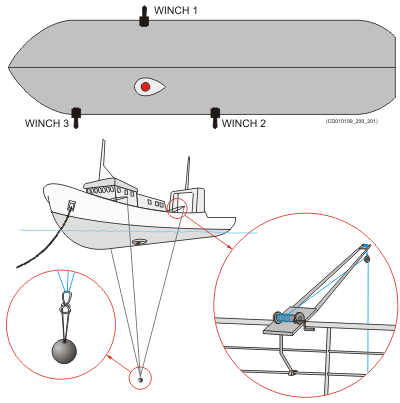2 Preparing the vessel for EK80 calibration
Prior to calibration, a suitable geographical location must be found. The necessary equipment for lowering, hoisting and handling the target sphere must be set up. The rigging description is to a great extent reproduced from ICES report 326.
Context

It is desirable to work in water as deep as possible. You must maintain a stable platform. Both bow and stern anchoring or mooring is strongly recommended.
Set up winches to guide and steer the lines to the sphere. You need to move the sphere within the beam, so the length of the individual wires must be easily adjustable. Mount the winches to the deck railing in accordance with the transducer location. Each winch must be provided with a long spool of 0.60 mm diameter monofilament nylon line. The lines must be marked with small swivels at 5 m intervals, beginning 10 m from the loose end.
The purpose of the swivels is threefold:
| • | They will unravel rotation of the nylon line |
| • | They will mark distances on the line |
| • | They will add weight so that the line sinks in water |
Note
Each calibration sphere must be handled with care to avoid any damage to its surface. When not in use, store the sphere in a household soap solution. All suspension lines must be as thin and clean as possible. Limit knots to a minimum, and keep them small. Even knots have strong echoes!
Procedure
| 1 | Locate a suitable geographical area for the calibration.
|
| 2 | Ensure that the depth is sufficient for clear separation of sphere and bottom echoes. |
| 3 | Anchor the vessel. Note
If the vessel is anchored or moored only fore or aft, the wind will cause it to drift sideways. If the current then attacks with a different angle, it will make a bad situation even worse. If the vessel is allowed to move sideways, or if the current runs abeam, this will normally give larger variations in the
EK80 performance. This results in poor and not reliable calibration accuracy.
|
| 4 | Pull a rope beneath the hull from one side of the vessel to the other. |
| 5 | Place the first winch in the transverse plane of the vessel running through the transducer. If the transducer is mounted on one side of the keel, place the first winch on the opposite side of the vessel.
|
| 6 | Place the second and third winches on the same vessel side as the transducer and at equal distances from the transverse section containing the transducer and first winch. |